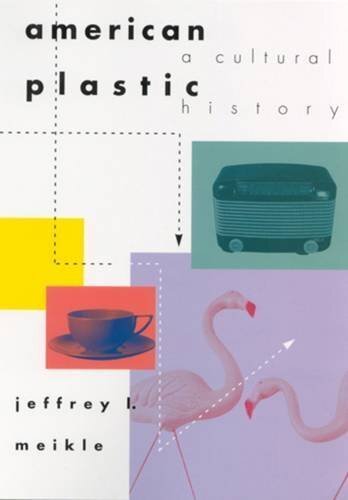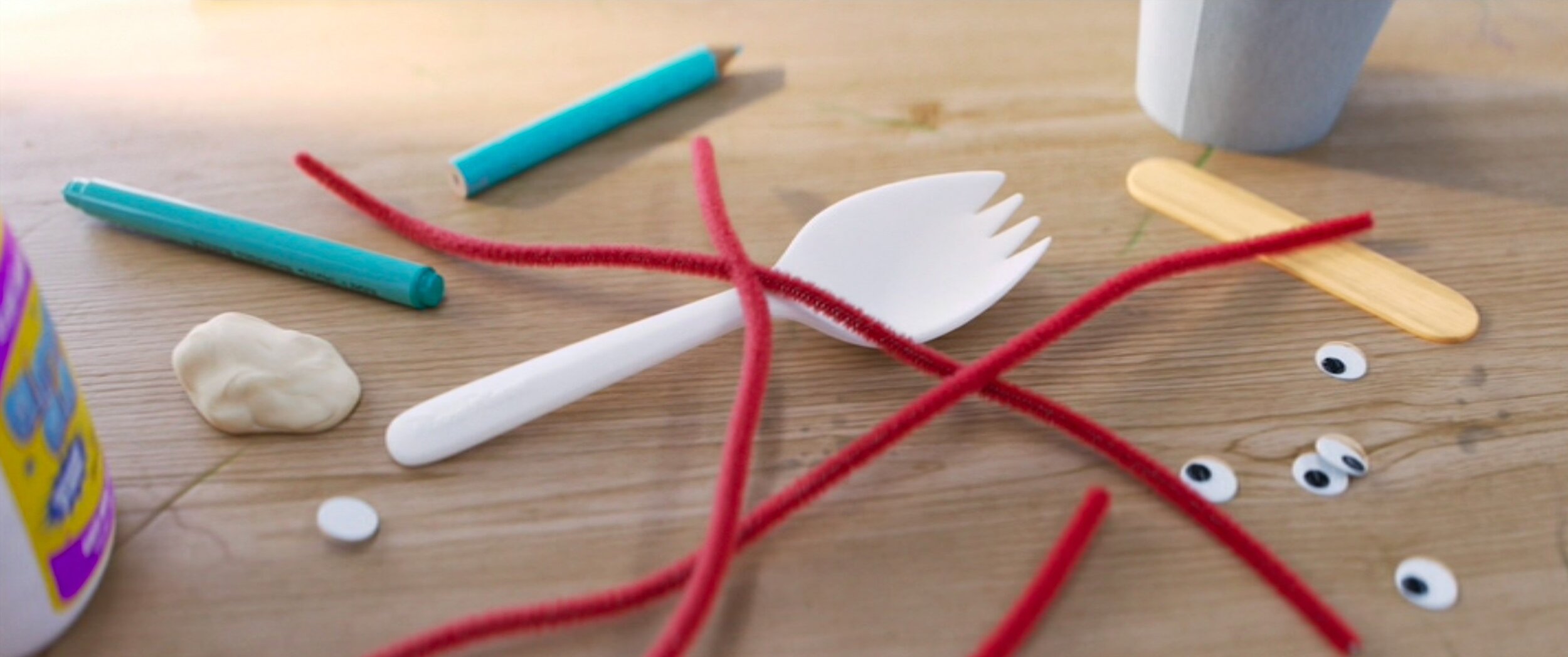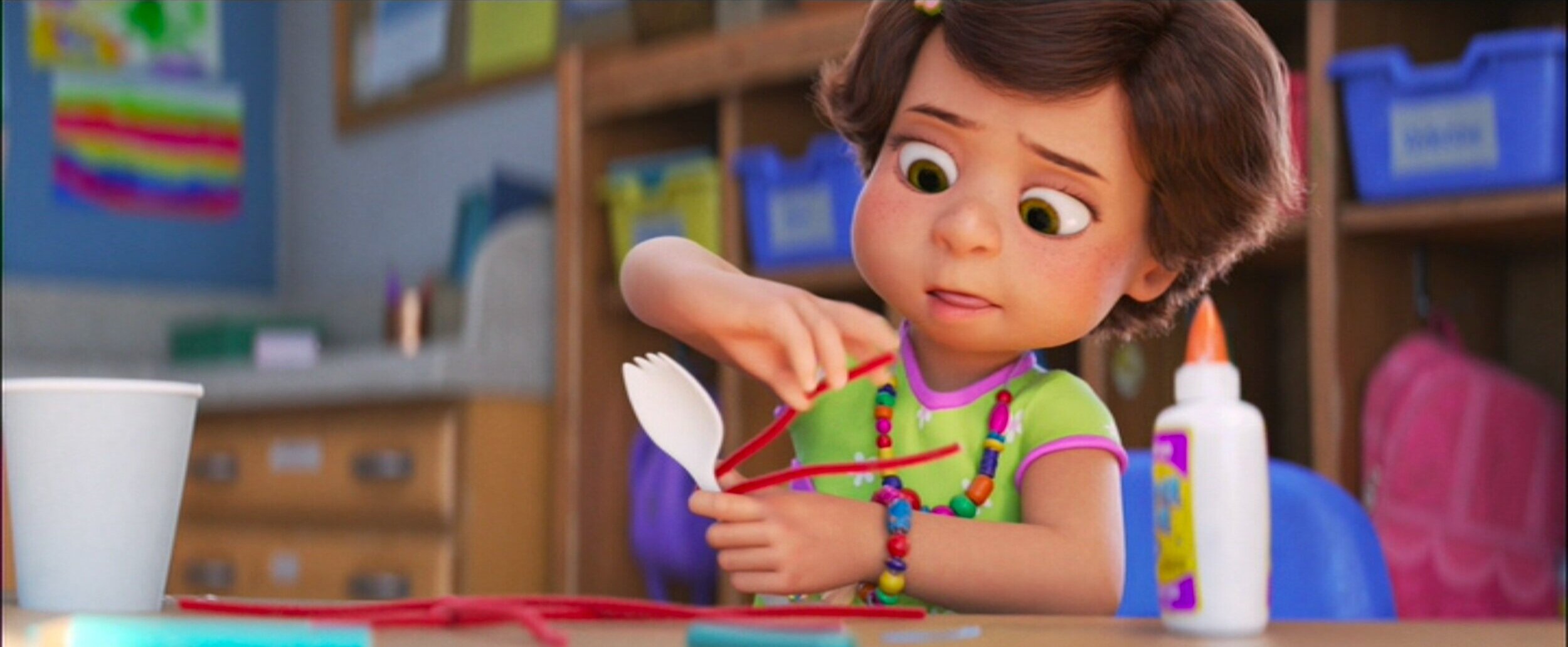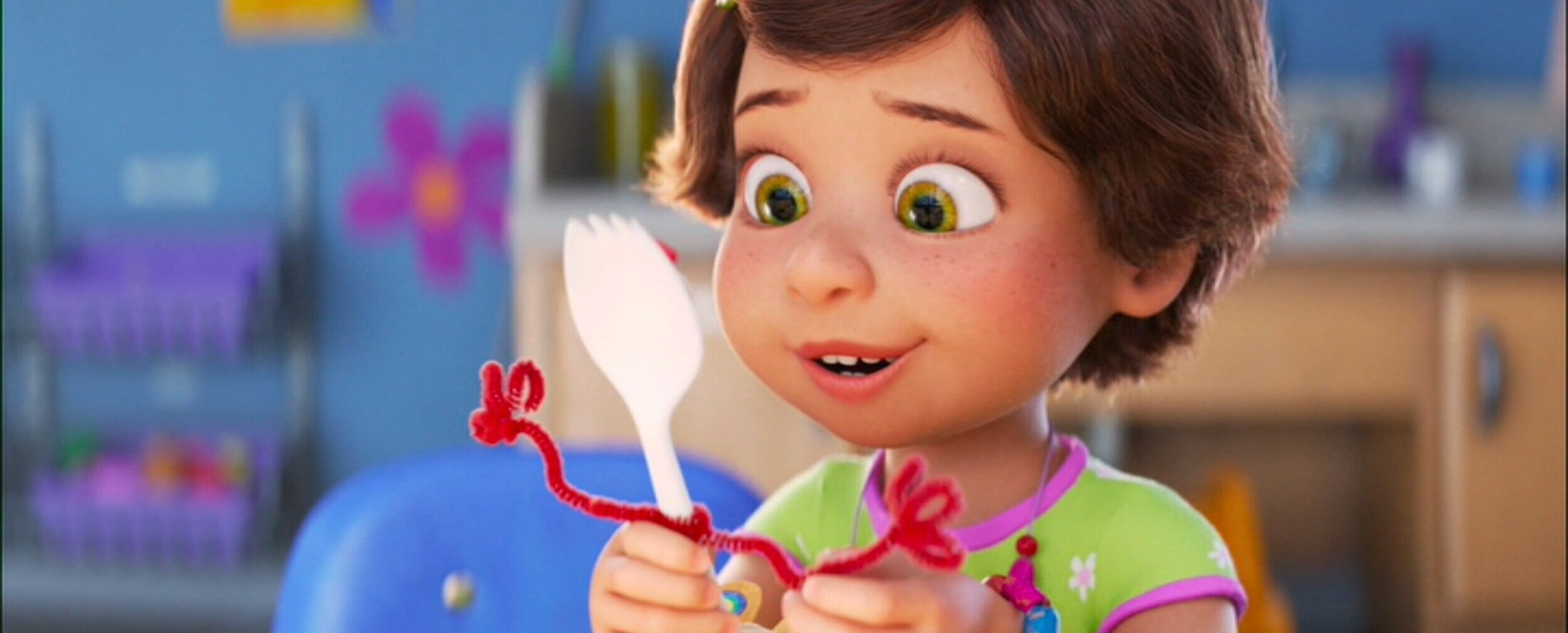Animating Plastic in the Toy Story Films
WOODY: Tuesday night’s plastic corrosion awareness meeting was, I think, a big success. And we wanna thank Mr. Spell for putting that on for us.
Toy Story (1995)
Pixar’s Toy Story (1995-2019) series explores a landscape full of plastic. Most of the main characters are plastic. Sheriff Woody isn’t made out of wood at all; his head, hands, and boots are all plastic. Mr. and Mrs. Potato Head, and their many anatomical add-ons, are plastic. T-Rex is plastic. The little soldiers are plastic, as are their parachutes. Mr. Spell’s outer shell is plastic. And Buzz Lightyear, when he first arrives in Toy Story (John Lasseter, 1995), is the shiniest, newest, most gorgeous piece of plastic anyone has ever seen (Fig. 1). Yet the toys exhibit a highly ambivalent relationship with their plastic bodies. Being plastic is often a source of anxiety or embarrassment for them, and they repeatedly bring attention to the fact that they are made of synthetic plastic materials. Addressing the rest of the toys as their sheriff, Woody happily announces: “Tuesday night’s plastic corrosion awareness meeting was, I think, a big success!” Later in the film, when the toys are marvelling over Buzz’s wings, Woody mocks: “What? These are plastic… He can’t fly!” This reflexivity about their material composition continues in later instalments. In Toy Story 3 (Lee Unkrich, 2010), the evil Lotso threatens Woody: “You think you’re special, cowboy? You’re a piece of plastic… you were meant to be thrown away!” On the one hand, then, being plastic emerges as something which is a source of shame (if Buzz’s wings were indeed plastic and not ‘trillium-carbonic alloy’ as he claims, this would make them somehow counterfeit, phony, incapable of flying); plastic is a material that carries with it the threat of worthlessness (hence Lotso’s threat to Woody that he belongs in the bin; that his plastic body is innately disposable). Simultaneously, however, plastic is a vulnerable, vital materiality that deserves care and protection (as seen in Woody’s ‘plastic corrosion awareness meeting’ and its reported success).
In this blog post, I take the tentative first steps in exploring what it means to animate plastic: the means by which the “plastic” objects enter into the “plastic” digital space. Animating plastic, we will see, necessarily involves a doubling by which plastic forms and materials enter a digital space in which they come into contact with the fantastical plasticity of animation itself. In my analysis, I want to bring the Toy Story series into dialogue with a range of theorists of plastic and plasticity. Approaching plastics, and the fantastical process of animating plastics, through the diverse lenses of cultural history, philosophy, ecology, neuroscience, and animation studies, I wish to highlight the ambivalent and ever-mutating landscape that is ‘life in plastic’ (to echo Aqua’s famous lyric from Barbie Girl). My argument is that the Toy Story films necessarily inherit plastic’s messy and complex materiality, and that Pixar’s embrace of plastic does not simply present us with a serene, fantasy landscape of shiny forms and bright colours, but rather embarks upon a much more complex exploration of plastic’s intimate relations to anxiety, loss, and even grief.
Our ambivalent cultural relationships with plastic, as dramatized in Pixar’s Toy Story films, have been explored in detail by scholars across many disciplines. Jeffrey L. Meikle’s American Plastic: A Cultural History (1995) (Fig. 2) maps the conflicting socio-cultural responses to the boom in manufacturing plastic materials in the 20th century, demonstrating how plastic simultaneously promised an almost utopic world of endless malleability, alongside suspicions as to the fake or counterfeit nature of plastic: “a new industry came into being, its promoters perpetually caught between a sense of wonder at plastic’s utopian potential as a democratizing agent, and a recurring suspicion that plastic exemplified the cheap, the shoddy, and the meretricious” (1999: xiv).
It is not just that cultural responses to plastic are ambivalent, however, but that synthetic plastic, itself, as a material, acts in whole host of unpredictable and contradictory manners. The art historian Roksana Filipowska, for instance, analyses the use of synthetic plastics in artworks, and details the work of preservation and restoration that these artworks require. Whilst plastic has a reputation for being an unchanging, non-biodegradable material, she demonstrates that it is in fact a surprisingly vulnerable material that degrades and mutates in ways which require distinct modes of curatorial care (2019: 2020). Just as the toys in Toy Story attempt to raise awareness of corrosion in their meetings, the plastics explored by Filipowska are also often volatile and unstable.
Indeed, the volatility and malleability on a material or chemical level of plastic seems to overspill disciplinary boundaries. Plastic is never just about plastic. The interdisciplinary work of the contemporary philosopher Catherine Malabou takes the concept of ‘plasticity’ as it is central focus, charting different forms of plastics and plasticities across philosophy, neuroscience, epigenetics, art, robotics, and many other areas. Malabou writes: “Plastic material is a synthetic material which can take on different shapes and properties according to the functions intended. “Plastic” on its own is an explosive material with a nitro-glycerine and nitrocellulose base that can set off violent detonations” (2005: 8). Again, we begin to see this highly ambivalent, volatile nature of plastic: Malabou insists throughout her work—in relation to diverse forms of plasticity, most strikingly the (neuro)plasticity of the brain (2008, 2012)—that plasticity is simultaneously malleable and vulnerable. Plasticity’s transformability does not render it all powerful, but entails an inevitable exposure to loss: if the (neuro)plasticity of the human brain entails both the biological capacity to learn and develop throughout life, it also describes the vulnerability to total neural destruction in instances of brain trauma or neurological disease. Malabou shows this most poignantly in her analysis of the ‘destructive plasticity’ of brain disease in works like The New Wounded (2012) and Ontology of the Accident (2012), in which people’s identities can become radically altered following brain events.
The restlessness of plasticity which Malabou brings to light—simultaneously transforming and exploding, creating and destroying, and constantly transcending classificatory boundaries—is also present in Meikle’s and Filipowska’s accounts of synthetic plastics. Plastic, as a material, is inseparable from plasticity: a broader conceptualisation of how things change, mutate, and transform. Meikle shows how plastic is not just an inanimate material; wherever it entered mass production on a global scale, it necessarily brought with it a philosophy of malleability that affects the way we think and live. Meikle notes: ‘everyday experience became ever more malleable ever more a matter of plasticity, with both place and personality apparently open to creative remolding and reshaping in a postmodern society’ (1995: xiv). Strikingly, Meikle refers explicitly to computer animation in his mapping of a world increasingly composed of plastics and plasticities across the 1980s and 90s:
Experience promised to become more malleable, more synthetic, through computer animation and holographic projection. Immateriality triumphed as the medium of artifice shifted from plastics to electronics, form long-chained molecules to flowing electrons. This apparent dissolving of limits made anything and everything seem possible […] (1995: 8)
So, computer animation seems to arrive in order to transpose the promise of omni-malleability inherent in synthetic plastics into the digital or virtual sphere, extending this promise further beyond all terrestrial constraints. Indeed, in his own exploration of plastic in Pixar, William Schaffer (2004) underlines the particularly intrinsic relation between early computer animation and synthetic plastics, suggesting that Pixar chose plastic protagonists for Toy Story because these synthetic materials were easier to render digitally at the time. So, then, given this inextricable and ever-morphing relationship between plastic forms and animation’s promise of plasticity, what does it really mean to animate plastic using computer animation? What occurs in at the site of this strange doubling whereby plastic forms and animation’s own plasticity meet? If Meikle is correct that computer animation drags plastics off into the ether, then the Toy Story series would seem to capture precisely this moment of encounter between plastic and its further plasticization of plastic in digital space.
Toy Story 4 (Josh Cooley, 2019) is a fascinating exploration of what it means to animate plastic. Like its predecessors, its exploration of plastic is highly ambivalent: it is not just the all-wondrous material of hyper-malleable modernity, but it is also tinged with vulnerability, disposability, even embarrassment and shame. Particularly strong in Toy Story 4, however, and indeed as intimately related to the question of the toys’ plastic embodiment, are the central themes of loss, grief and letting go. These themes were made particularly clear to me through the very personal context in which I saw the film. Toy Story 4 came out in the UK around a week after my mom died. As I left the screen sobbing, one of the cinema employees kindly said: “Don’t worry, it had the same effect on me.” The Toy Story films were some of my mom’s absolute favourites. I remember her taking me to Wolverhampton Cineworld to see the first one when I was four, and to see the second when I was eight. It was impossible not to be struck by the centrality of the film’s themes of loss, grief, and letting go. Goodbyes are said in Toy Story 4 that are more final than anything seen in the series so far, and which ask complex questions of loss, mourning, and release.
Toy Story 4 catches up with Woody, Buzz, and the rest of the playroom, who now belong to Bonnie: a young girl to whom a grown-up Andy donated a box of all his toys at the end of Toy Story 3, before leaving home and beginning collage. When Bonnie starts at nursery, she makes a new toy for herself out of a plastic fork and some pipe cleaners recovered by Woody from the bin, calling her new creation ‘Forky’ (Fig. 3). On the way home from nursery, Forky comes to life. Repeatedly exclaiming ‘I’m trash!’, Forky keeps trying to throw himself into the bin. However, on a family trip to a caravan park and funfair, the other toys battle to keep Forky away from the bin and by Bonnie’s side. At the film’s close, Woody will ultimately decide not to return to Bonnie alongside the other toys, including his best friend Buzz. Instead, he will live out in the wild at the funfair.
It is striking that the main new character in this film about loss and saying goodbye is a plastic fork that had been destined for the trash. Forky seems to embody all of the fears communicated about plastic shared by the toys in the previous films: flimsy, cheap, disposable, trash. Yet his fantastical genesis at the hands of Bonnie is presented as a moment of pure joy and plastic creation. We see Bonnie take the plastic materials in front of her and sculpt them into various forms. We see her fingers mould a bit of plasticine into a smile on Forky’s face, and fashion the pipe cleaners into arms (Figs. 4 and 5). Forky at this point is bathed in angelic lighting. It seems here like Pixar is referencing their own creative process as animations. It is striking, then, that this particular reference to the process and to the technology of animation involves the moulding of plastic objects and materials in order to bring them to life; it is also important that these are not just any plastic materials, but trash—materials that had been finished out of the bin. Indeed, Christopher Holliday identifies a distinct preoccupation in computer animated films with depicting trash and detritus, commenting: “It is within such disorganised clutter and unwanted remnants that computer-animated films seek out their treasures, prizing the spectacle of those things whose values can be made foreign through imported mechanisms that disengage the waste object from its initial purpose” (2018: 111). Forky, then, another ‘treasure’ of animated plastic trash, becomes a figure of fantasy at the intersection of plastic’s ambivalent nature (malleable, vulnerable, losable) and computer animation’s inheritance, or even embrace, of this ambivalence.
Cut to the end of the film. Bonnie’s family have just departed the carnival, leaving Woody behind. The toys engineer the van to turn around back to the carnival to pick up Woody. They eventually manage to bring the van to a halt in front of the carousal where Woody is waiting. The van knocks over a bin in the process, with plastic detritus spilling all over the grass, echoing the theme of waste, trash, and obsolescence that runs throughout the Toy Story films, and which constitute points of anxiety and fear for the plastic toys. It is significant that this dramatic moment of the unsettling of the bin and the spilling of waste plastics precedes probably the most significant moments of loss in the entire Toy Story franchise: the letting go of Woody.
Woody’s final decision not to return with the other toys but to let go and stay with Bo Peep (who is also living in the wild at the funfair, having been given away previously) is presented as a moment of serenity and beauty; the scene is lit by the full moon, and by the sparkling artificial lights of the carnival. The film series has always been about a kind of rejection of loss-phobic preservation (most notably this is the case in Toy Story 2 (John Lasseter, 1999) in which Woody is preparing for life in a museum collection, restored and preserved, unloved, behind glass); but Toy Story 4 actively embraces material wasting, decay and loss as an irreducible lifeforce within ‘life in plastic’.
We see, then, that plastic’s material volatility is reflected in the film series’ affective and existential journey: the film series’ themes of feeling like trash, being lost, and letting go are articulated across both synthetic material surfaces and characters’ complex psychological make-ups. Hearts and minds in the Toy Story films experience loss and grief in ways which are inseparable from how plastic materials experience loss. This inseparability between material and psychic life echoes throughout the theorists of plastic(ity) mentioned above, and is demonstrated particularly poignantly in relation to the question of the (neuro)plasticity of the brain in Malabou’s work: the biological materiality of the brain demonstrates that (neuro)plastic form is the very basic psychic life itself. The joys, losses, grief, and transformations that make up and animate psychic life are themselves nothing but plastic forms.
The work of Katie Schaag further explores plastic embodiment between organic bodies and synthetic landscapes, inviting us all to consider our own place within these landscapes. From her work on expressing biological plasticity in performance, to ecologies of synthetic plastic materials, her writing attempts to find ways in which we can all discover and express what is plastic and mutable in ourselves, or how we become plastic and transform in relation to our environment. Schaag shows how we can no longer think of plastic materials as separate from nature; rather, we must consider how plastics operate outside and within us an ecology, changing our embodied and psychic identities: “An ecological awareness of our bodies becoming-plastic may allow us to relinquish our illusions of individual sovereignty, and let ourselves slip into the ebb and flow of the sea of actants within us” (2020: 14). She continues: “Once we relinquish our commitment to the idea that plastic is separate from animals, minerals, and vegetables, we can become open to an awareness of the more than human plastic ecological web” (2020: 15). This occurs, then, in a relinquishing of any ideas of purity and sovereignty surrounding the body; a letting go that accepts the messiness of embodiment in an ecosystem of synthetic plastics, unforeseen forms, and virtual, plastic worlds.
In Toy Story 4, between Forky’s own animation of plastic waste, and Woody’s saying goodbye, the film teaches a messy embrace of plastic life that entails relinquishing previous structures of property and ownership (a theme evoked throughout the Toy Story films by the inscription of the child’s name on the feet of their favourite toys; see Lewis Roberts [2017] for further discussion of these themes), a relinquishing of any hope of ending up intact, and a peaceful self-abandonment to the emancipatory loss of static self that comes with being freely plastic.
Pasi Väliaho, in his article “Animation and the Powers of Plasticity,” argues that animation is about power, and that certain animations: “seek to repress the nagging feeling of one’s metaphysical limitations, thereby bending the real into a play as well as a battleground of fantasy—a fantasy, not only of metamorphosis, but crucially, of omnipotence” (2017: 270). However, the Toy Story films do the exact opposite. They not harness the fantasy of animation for power: rather it approaches, through animation, the vitality of plastic life precisely through its vulnerability and its embrace of loss.
**Article published: November 13, 2020**
References
Filipowska, Roksana. “Dieter Roth’s Use of Food and Polyvinyl Chloride (PVC)”, [talk as part of the panel “Plasticene: Material and Conceptual “Plastics” in the Practice, History, and Conservation of Art” at the 107th College Art Association conference, New York City, February 14, 2019].
Filipowska, Roksana. “Plasticity Against Plastic: Synthetics in the Practice, Theory, and Conversation of Art Since the 1960s,” (2019). Publicly Accessible Penn Dissertations. 3423, available at: https://repository.upenn.edu/edissertations/3423.
Holliday, Christopher. The Computer Animated Film: Industry, Style and Genre (Edinburgh: Edinburgh University Press, 2018).
Malabou, Catherine. Ontology of the Accident, trans. by Carolyn Shread (Cambridge: Polity Press, 2012).
Malabou, Catherine. Plasticity at the Dusk of Writing: Dialectic, Destruction, Deconstruction, trans. by Carolyn Shread (New York; Chichester: Columbia University Press, 2010).
Malabou, Catherine. The Future of Hegel: Plasticity, Temporality and Dialectic, trans. by Lisabeth During (London: Routledge, 2005).
Malabou, Catherine. The New Wounded: From Neurosis to Brain Damage, trans. by Steven Miller (New York: Fordham University Press, 2012).
Malabou, Catherine. What Should We Do With Our Brain?, trans. by Sebastian Rand (New York: Fordham University Press, 2008).
Meikle, Jeffrey L. American Plastic: A Cultural History (New Brunswick: Rutgers University Press, 1995).
Roberts, Lewis. ““It’s a dangerous world out there for a toy”: Identity Crisis and Commodity Culture in the Toy Story movies,” Children’s Literature Association Quarterly 42, no. 4 (2017): 417-437.
Schaag, Katie, “Biological Plasticity and Performative Possibility in the Work of Catherine Malabou and Curios,” in Inter Views in Performance Philosophy: Crossings and Conversations, eds. Anna Street, Julien Alliot, and Magnolia Pauker (London: Palgrave Macmillan, 2017), 145-60.
Schaag, Katie. “Plastiglomerates, Microplastics, Nanoplastics: Toward a Dark Ecology of Plastic Performativity,” Performance Research 25 ,no. 2 (2020): 14-25.
Schaffer, William. “The Importance of Being Plastic: The Feel of Pixar,” Animation Journal 12 (2004): 72-95.
Väliaho, Pasi. “Animation and the Powers of Plasticity,” animation: an interdisciplinary journal 12, no. 3 (2017): 269-271.
Biography
Benjamin Dalton is a researcher in contemporary French thought and culture. He recently received his PhD in French from King’s College London with his thesis entitled: ‘Plasticity in Contemporary French Thought, Literature and Film: Witnessing Transformations with Catherine Malabou’. He has recently published an article on plasticity in the writing of Marie Darrieussecq entitled ‘Forms of Freedoms: Marie Darrieussecq, Catherine Malabou, and the Plasticity of Science’ in Dalhousie French Studies (vol. 115, 2020, pp. 55-73), a book chapter on queerness and plasticity entitled ‘Cruising the Queer Forest with Alain Guiraudie: Woods, Plastics, Plasticities’ in Beasts of the Forests: Denizens of the Dark Woods, eds. Jon Hackett and Seán Harrington (East Barnet: John Libbey, 2019, pp. 65-91), and an interview with Catherine Malabou in Paragraph (vol. 42, no. 2, 2019, pp. 238-54). He also led the collaborative project ‘Narrating Plasticity: Stories of Transformations between the Plastic Arts and Neurosciences’, which was funded by the Culture team at King’s, and brought together researchers in clinical neuroscience with the ceramicist Amanda Doidge. He currently teaches English language and literature at Paris Nanterre University and the New Sorbonne University in Paris. Dalton recently gave a collaborative talk with film studies and animation scholar Christopher Holliday on 11th November 2020 at King’s College London, entitled: ‘From Mickey to Malabou: Plasmaticness, Plasticity, and the Limits of Formation’. This talk further develops dialogues between Dalton’s work on plasticity in Malabou’s philosophy and Holliday’s work on Sergei Eisenstein’s concept of ‘plasmaticness’ in relation to computer animation.





